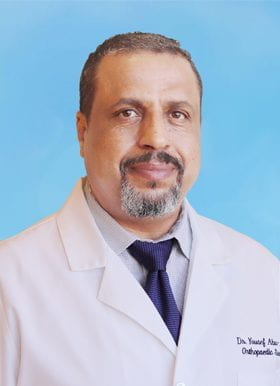
Yousef Abu-Amer, PhD
Dr. J. Albert Key Professor
- Phone: 314-362-8597
- Fax: Institute of Health | 11th floor | #11614
- Email: abuamery@nospam.wustl.edu
My laboratory investigates molecular steps critical for development and progression of such diseases related to osteoclasts. In short, we investigate molecular mechanisms of osteoclast differentiation and activation under inflammatory conditions. These include identifying the molecular mechanisms of pro- and anti-inflammatory cytokines that regulate osteoclastogenesis. The ultimate goal of these studies is to develop therapies at the signal transduction level to combat and eradicate these disabling and morbid diseases.
Recent estimates indicate that over 60 million Americans suffer from inflammatory joint diseases and that arthritis is the leading disease causing disability in the US. According to CDC reports, the prevalence of arthritis is bound to significantly increase over the next two decades in America. One of the most devastating complications of inflammatory arthritis is the excessive systemic and local bone loss associated with advanced and late stages of the disease which is further more pronounced in the elderly.
Although numerous inflammatory bone disorders can be treated with anti-inflammatory approaches, copious cases require surgical intervention. In this regard, over half a million total hip and knee arthroplasties are carried out annually in the USA alone (not restricted to arthritis). A large number of these cases ends up several years later in the operating room for surgical revisions. One of the principal causes of inflammatory osteolysis that attend orthopedic implant failure is implant-derived wear debris that activate and recruit macrophages and osteoclasts around and at the implant-host interface. These cells mediate and accelerate the inflammatory and osteolytic responses leading to loosening and failure of bone implants. Subsequent revision surgery of the failing joint implant, is often more difficult, and associated with increased morbidity and mortality especially among aging patients with compromised bones. Therefore, the need for effective approaches to diagnose, prevent, and treat complications of total joint replacement have risen in recent years. Thus, better understanding of the processes and mechanisms underlying pathologic and osteolytic events leading to joint failure is essential to provide appropriate preventive and therapeutic countermeasures.
The pathological response to arthritic bone erosion and implant wear-debris entails recruitment and activation of a wide range of cells responsive to immune and inflammatory cues, such as macrophages, neutrophils, megakaryocytes, and osteoclasts. Recent work by several groups including ours has identified important cellular entities and secreted factors that contribute to inflammatory osteolysis. Using cell culture and in vivo animal models, my laboratory has made important contributions to understanding the molecular basis of inflammatory bone loss.
The mechanisms underlying inflammatory bone loss diseases rely on the RANKL/RANK system which is required for basic osteoclast formation (this cell is required for osteolysis), and also rely on overlapping inflammatory signals, primarily cytokine-induced IKK-NFkB and MAP kinase pathways. The combination of these signaling events results with exacerbation of and exaggerated inflammatory bone loss responses. Such responses are manifested in bone loss that accompanies rheumatoid arthritis, tumor-associated osteolysis, and orthopedic implant osteolysis.
